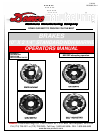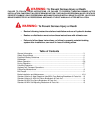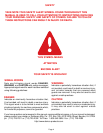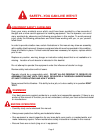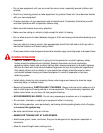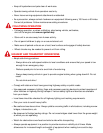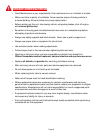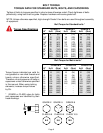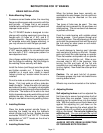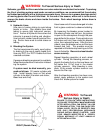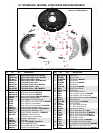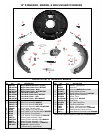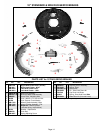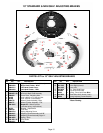
Page 11
WARNING: To Prevent Serious Injury or Death
Saltwater, granular fertilizers and other corrosive materials are destructive to metal. To prolong
the life of a braking system used under corrosive conditions, we recommend that the actuator
be flushed periodically with a high pressure water hose. Be sure to re-grease bearings and oil
all moving parts after the unit has dried. At the end of the season, when unit is to be stored,
remove the brake drums and clean inside the brakes. Pack wheel bearings before drum is
installed.
Have loose end of hose submerged in brake
fluid in glass container to observe bubbling.
By loosening the bleeder screw located in
the wheel cylinder one half turn, the system
is open to the atmosphere through the pas-
sage drilled in the screw. Pump actuator one
full stroke and hold. Now close the bleeder
valve, then release the lever. After the lever
is back, open the bleeder valve, pull the lever
forward and hold. This process must be
repeated until bubbles stop coming out of the
hose in the bottle. Be sure to close bleeder
screw securely.
Repeat bleeding operation at each wheel
cylinder. During the bleeding process, re-
plenish the brake fluid, so the level does not
fall below the 1/2 full level in the master
cylinder reservoir. After bleeding is com-
plete, fill the master cylinder reservoir and
secure the filler cap.
After the bleeding operation has been com-
pleted, apply pressure to the system and
check the brake system for leaks.
WRONG
RIGHT (Double Flare)
5. Hydraulic Lines
Use care in forming tubing to avoid sharp
bends or kinks. Use double flare steel
tubing to assure tight leak-proof connec-
tions. Anchor all hydraulic lines at two foot
intervals to prevent chafing and vibration.
Use hydraulic rubber hose at points of flex-
ing. Anchor hose ends to avoid stress on
tubing.
6. Bleeding the System
The first requirement for safe, sure hydrau-
lic braking is the use of quality brake fluid.
Use only DOT-3 or DOT-4 brake fluid from
a sealed container.
If pressure bleeding equipment is available,
follow the manufacturer’s instruction in bleed-
ing the system.
If system must be bled manually, pro-
ceed as follows: Fill master cylinder with
fluid. Install bleeder hose on first wheel
cylinder to be bled (if tandem axle trailer,
bleed rear axle first).
WARNING: To Prevent
Serious Injury or Death
FAILURE TO FOLLOW THESE INSTRUCTIONS,
OR FAILURE TO PROPERLY MAINTAIN BRAKES
AFTER INSTALLATION, CAN RESULT IN LOSS
OF BRAKING ACTION. THIS CAN CAUSE PER-
SONAL INJURY, DEATH OR PROPERTY DAM-
AGE. ONLY PROFESSIONAL MECHANICS
SHOULD INSTALL BRAKE CLUSTERS. HAVE
YOUR BRAKES INSPECTED BY A PROFES-
SIONAL MECHANIC AT LEAST ANNUALLY
AFTER INSTALLATION.



